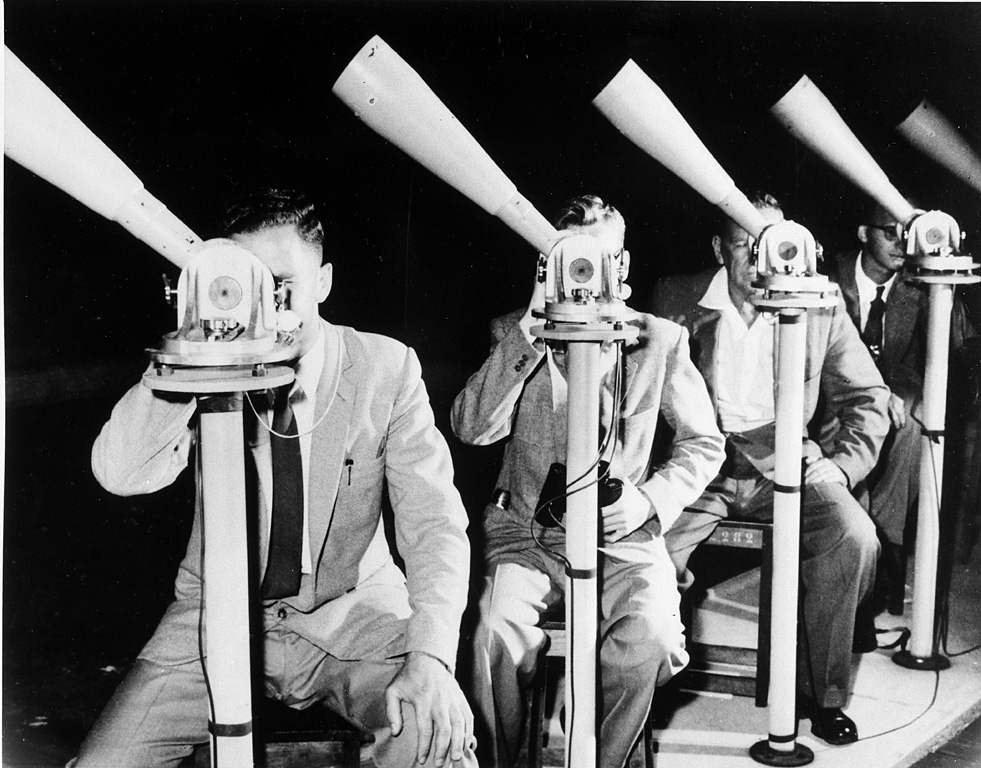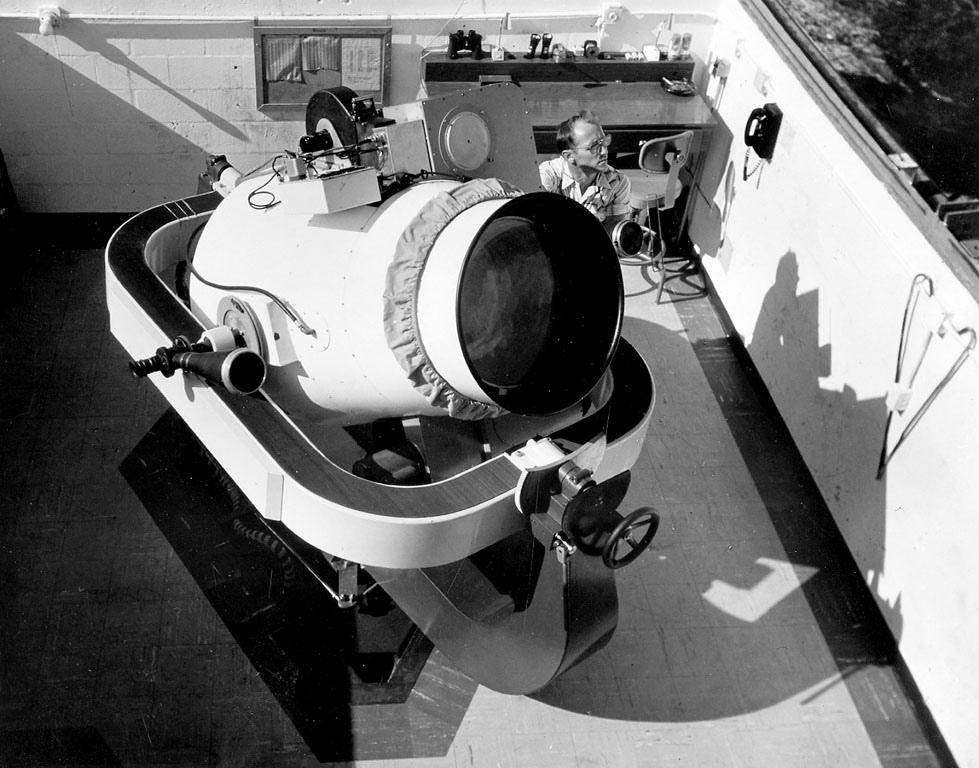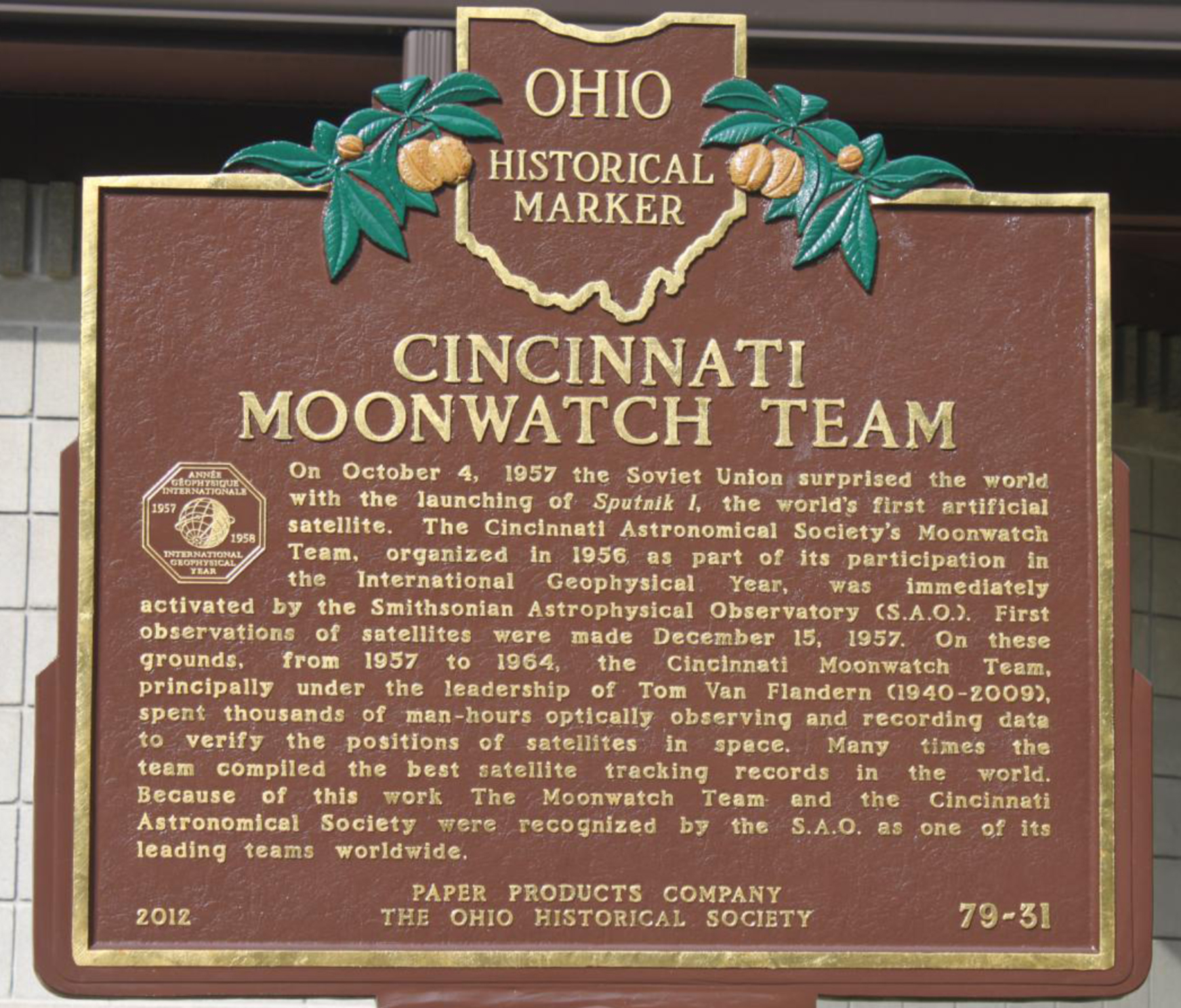Project Moonwatch on:
[Wikipedia]
[Google]
[Amazon]
 Operation Moonwatch (also known as ''Project Moonwatch'' and, more simply, as ''Moonwatch'') was an amateur science program formally initiated by the
Operation Moonwatch (also known as ''Project Moonwatch'' and, more simply, as ''Moonwatch'') was an amateur science program formally initiated by the
 Whipple envisioned a global network of specially designed instruments that could track and photograph satellites. This network, aided by a corps of volunteer satellite spotters and a computer at the
Whipple envisioned a global network of specially designed instruments that could track and photograph satellites. This network, aided by a corps of volunteer satellite spotters and a computer at the
 ''
''
"James A. Westphal, 74; Caltech Scientist Had Gift for Innovation,"
''Los Angeles Times.'' September 11, 2004. The program boosted science programs at many schools throughout the country and helped revitalize amateur science in the United States. The
Smithsonian Astronomers Keep Hectic Pace
– ''The Harvard Crimson''
– University of Hawaii
– NASA
– NASA
Eyes on the Sky
€“ Xavier University
– American Institute of Physics
Citizen Science, Old-School Style: The True Tale of Operation Moonwatch
– Universe Today Observational astronomy Scientific observation Citizen science
 Operation Moonwatch (also known as ''Project Moonwatch'' and, more simply, as ''Moonwatch'') was an amateur science program formally initiated by the
Operation Moonwatch (also known as ''Project Moonwatch'' and, more simply, as ''Moonwatch'') was an amateur science program formally initiated by the Smithsonian Astrophysical Observatory
The Smithsonian Astrophysical Observatory (SAO) is a research institute of the Smithsonian Institution, concentrating on Astrophysics, astrophysical studies including Galactic astronomy, galactic and extragalactic astronomy, cosmology, Sun, solar ...
(SAO) in 1956. The SAO organized Moonwatch as part of the International Geophysical Year
The International Geophysical Year (IGY; ), also referred to as the third International Polar Year, was an international scientific project that lasted from 1 July 1957 to 31 December 1958. It marked the end of a long period during the Cold War w ...
(IGY) which was probably the largest single scientific undertaking in history. Its initial goal was to enlist the aid of amateur astronomers and other citizens who would help professional scientists spot the first artificial satellites. Until professionally staffed optical tracking stations came on-line in 1958, this network of amateur scientists and other interested citizens played a critical role in providing crucial information regarding the world's first satellites.
Origins of Moonwatch
Moonwatch's origins can be traced to two sources. In the United States, there was a thriving culture of amateur scientists including thousands of citizens who did astronomy for anavocation
An avocation is an activity that someone engages in as a hobby outside their main occupation. There are many examples of people whose professions were the ways that they made their livings, but for whom their activities outside their workplaces w ...
. During the Cold War
The Cold War was a period of global Geopolitics, geopolitical rivalry between the United States (US) and the Soviet Union (USSR) and their respective allies, the capitalist Western Bloc and communist Eastern Bloc, which lasted from 1947 unt ...
, the United States also encouraged thousands of citizens to take part in the Ground Observer Corps
The Ground Observer Corps (GOC), sometimes erroneously referred to as the Ground ''Observation'' Corps, was the name of two American civil defense organizations during the middle 20th century.
World War II organization
The first Ground Observer ...
, a nationwide program to spot Soviet bombers. Moonwatch brought together these two activities and attitudes, melding curiosity and vigilance into a thriving activity for citizens. Moonwatch, in other words, was an expression of 1950s popular culture and fixed properly within the context of the Cold War
The Cold War was a period of global Geopolitics, geopolitical rivalry between the United States (US) and the Soviet Union (USSR) and their respective allies, the capitalist Western Bloc and communist Eastern Bloc, which lasted from 1947 unt ...
.
Moonwatch was the brainchild of Harvard
Harvard University is a private Ivy League research university in Cambridge, Massachusetts, United States. Founded in 1636 and named for its first benefactor, the Puritan clergyman John Harvard, it is the oldest institution of higher lear ...
astronomer Fred L. Whipple. In 1955, as the recently appointed director of the Smithsonian Astrophysical Observatory
The Smithsonian Astrophysical Observatory (SAO) is a research institute of the Smithsonian Institution, concentrating on Astrophysics, astrophysical studies including Galactic astronomy, galactic and extragalactic astronomy, cosmology, Sun, solar ...
in Cambridge, Massachusetts, Whipple proposed that amateurs could play a vital role in efforts to track the first satellites. He overcame the objections of colleagues who doubted ordinary citizens could do the job or who wanted the task for their own institutions. Eventually, Whipple carved out a place for amateurs in the IGY.
Moonwatch's members
In the late 1950s, thousands of teenagers, housewives, amateur astronomers, school teachers, and other citizens served on Moonwatch teams around the globe. Initially conceived as a way for citizens to participate in science and as a supplement to professionally staffed optical and radio tracking stations, Moonwatchers around the world found themselves an essential component of the professional scientists’ research program. Using specially designed telescopes, hand-built or purchased from vendors likeRadio Shack
RadioShack (formerly written as Radio Shack) is an American electronics retailer that was established in 1921 as an amateur radio mail-order business. Its parent company was purchased by Tandy Corporation in 1962, which shifted its focus from ma ...
, scores of Moonwatchers nightly monitored the skies. Their prompt response was aided by the extensive training they had done by spotting pebbles tossed in the air, registering the flight of moths, and participating in national alerts organized by the Civil Air Patrol
Civil Air Patrol (CAP) is a Congressional charter, congressionally chartered, federally supported Nonprofit corporation, non-profit corporation that serves as the official civilian auxiliaries, auxiliary of the United States Air Force (USAF). CA ...
.
Once professional scientists had accepted the idea that ordinary citizens could spot satellites and contribute to legitimate scientific research, Whipple and his colleagues organized amateurs around the world. Citizens formed Operation Moonwatch teams in towns and cities all around the globe, built their own equipment, and courted sponsors. In many cases, Moonwatch was not just a fad but an expression of real interest in science. By October 1957, Operation Moonwatch had some 200 teams ready to go into action, including observers in Hawaii and Australia
How Moonwatch worked
 Whipple envisioned a global network of specially designed instruments that could track and photograph satellites. This network, aided by a corps of volunteer satellite spotters and a computer at the
Whipple envisioned a global network of specially designed instruments that could track and photograph satellites. This network, aided by a corps of volunteer satellite spotters and a computer at the MIT Computation Center
The MIT Computation Center was organized in 1956 as a 10-year joint venture between the Massachusetts Institute of Technology and IBM to provide computing resources for New England universities. As part of the venture, IBM installed an IBM 704, whi ...
, would establish ephemerides
In astronomy and celestial navigation, an ephemeris (; ; , ) is a book with tables that gives the trajectory of naturally occurring astronomical objects and artificial satellites in the sky, i.e., the position (and possibly velocity) over time. ...
– predictions of where a satellite will be at particular times. The instruments at these stations were eventually designed by Dr. James G. Baker and Joseph Nunn and hence known as Baker-Nunn camera
A Schmidt camera, also referred to as the Schmidt telescope, is a catadioptric Astrophotography, astrophotographic Optical telescope, telescope designed to provide wide Field of view, fields of view with limited Aberration in optical systems, abe ...
s. Based on a series of super-Schmidt wide-angle telescopes and strategically placed around the globe at 12 locations, the innovative cameras could track rapidly moving targets while simultaneously viewing large swaths of the sky.
From the start, Whipple planned that the professionally staffed Baker-Nunn stations would be complemented by teams of dedicated amateurs. Amateur satellite spotters would inform the Baker-Nunn stations as to where to look, an important task given that scientists working on the Vanguard program likened finding a satellite in the sky to finding a golf ball tossed out of a jet plane. Amateur teams would relay the information back to the SAO in Cambridge where professional scientists would use it to generate accurate satellite orbits. At this point, professionals at the Baker-Nunn stations would take over the full-time task of photographing them.
During the IGY
 ''
''Sputnik 1
Sputnik 1 (, , ''Satellite 1''), sometimes referred to as simply Sputnik, was the first artificial Earth satellite. It was launched into an elliptical low Earth orbit by the Soviet Union on 4 October 1957 as part of the Soviet space program ...
's'' sudden launch was followed less than a month later with the Soviets orbiting Sputnik 2
Sputnik 2 (, , ''Satellite 2'', or Prosteyshiy Sputnik 2 (PS-2, , ''Simplest Satellite 2'', launched on 3 November 1957, was the second spacecraft launched into Earth orbit, and the first to carry an animal into orbit, a Soviet space dog named ...
and the dog Laika
Laika ( ; , ; – 3 November 1957) was a Soviet space dog who was one of the first animals in space and the first to orbit the Earth. A stray mongrel from the streets of Moscow, she flew aboard the Sputnik 2 spacecraft, launched into lo ...
. It was Moonwatch teams, networked around the world, who provided tracking information needed by scientists in Western nations. For the opening months of the Space Age, members of Moonwatch were the only organized worldwide network that was prepared to spot and help track satellites. The information they provided was complemented by the radio tracking program called Minitrack
The Minitrack Network was the first U.S. satellite tracking network to become operational, in 1957. It was used to track the flights of Sputnik, Vanguard, Explorer, and other early space efforts. Minitrack was the progenitor of Spacecraft Tracki ...
the United States Navy operated as well as some information from amateur radio
Amateur radio, also known as ham radio, is the use of the radio frequency radio spectrum, spectrum for purposes of non-commercial exchange of messages, wireless experimentation, self-training, private recreation, radiosport, contesting, and emer ...
buffs.
In many cases, Moonwatch teams also had the responsibility of communicating news of Sputnik
Sputnik 1 (, , ''Satellite 1''), sometimes referred to as simply Sputnik, was the first artificial Earth satellite. It was launched into an elliptical low Earth orbit by the Soviet Union on 4 October 1957 as part of the Soviet space progra ...
and the first American satellites to the public. The public responded, in turn, with infectious enthusiasm as local radio stations aired times to spot satellites and local and national newspapers ran hundreds of articles that described the nighttime activities of Moonwatchers.
Moonwatch caught the attention of those citizens interested in science or the Space Race
The Space Race (, ) was a 20th-century competition between the Cold War rivals, the United States and the Soviet Union, to achieve superior spaceflight capability. It had its origins in the ballistic missile-based nuclear arms race between t ...
during the late 1950s and much of the general public as well. Newspapers and popular magazines featured stories about Moonwatch regularly; dozens of articles appeared in the ''Los Angeles Times
The ''Los Angeles Times'' is an American Newspaper#Daily, daily newspaper that began publishing in Los Angeles, California, in 1881. Based in the Greater Los Angeles city of El Segundo, California, El Segundo since 2018, it is the List of new ...
'', ''The New Yorker'', and the ''New York Times
''The New York Times'' (''NYT'') is an American daily newspaper based in New York City. ''The New York Times'' covers domestic, national, and international news, and publishes opinion pieces, investigative reports, and reviews. As one of ...
'' alone. Meanwhile, in the U.S. local businesses sponsored teams with monikers like Spacehounds and The Order of Lunartiks. Meanwhile, Moonwatch teams in Peru, Japan, Australia, and even the Arctic regularly sent their observations to the Smithsonian.
Moonwatch complemented the professional system of satellite tracking stations that Fred Whipple organized around the globe. These two networks – one composed of amateurs and the other of seasoned professionals – helped further Whipple's personal goals of expanding his own astronomical empire. Operation Moonwatch was the most successful amateur activity of the IGY and it became the public face of a satellite tracking network that expanded the Smithsonian's global reach. Whipple used satellite tracking as a gateway for his observatory to participate in new research opportunities that appeared in the early years of space exploration.
In February 1958, President Dwight D. Eisenhower
Dwight David "Ike" Eisenhower (born David Dwight Eisenhower; October 14, 1890 – March 28, 1969) was the 34th president of the United States, serving from 1953 to 1961. During World War II, he was Supreme Commander of the Allied Expeditionar ...
publicly thanked the SAO, Fred Whipple, and the global corps of satellite spotters that comprised Moonwatch for their efforts in tracking the first Soviet and American satellites.
Moonwatch after the IGY
Even after the IGY ended, the Smithsonian maintained Operation Moonwatch. Hundreds of dedicated amateur scientists continued to help NASA and other agencies track satellites. Their observations often rivaled those of professional tracking stations, blurring the boundary between professional and amateur. Moonwatch members and the Smithsonian were important contributors to US Department of Defense satellite tracking research and development efforts, 1957–1961; seeProject Space Track
Project Space Track was a research and development project of the US Air Force, to create a tracking system for all artificial satellites of the Earth and space probes, domestic and foreign.
Project Space Track was started in 1957 at the Air For ...
.
Moonwatch continued long after the IGY ended in 1958. In fact, the Smithsonian operated Moonwatch until 1975 making it one of the longest running amateur science activities ever. As the fad of satellite spotting passed, the Smithsonian refashioned Operation Moonwatch to perform new functions. It encouraged teams of dedicated amateurs to contribute increasingly precise data for satellite tracking. Moonwatchers adapted to the needs of the Smithsonian through the activities of "hard core" groups in places like Walnut Creek, California. Throughout the 1960s, the Smithsonian gave them ever more challenging assignments such as locating extremely faint satellites and tracking satellites as they re-entered the Earth's atmosphere.
At times, the precise observations and calculations of dedicated skywatchers surpasses the work of professionals.
One of the most notable activities of Moonwatchers after the IGY was the observance of Sputnik 4 when it reentered the atmosphere in September 1962. Moonwatchers and other amateur scientists near Milwaukee
Milwaukee is the List of cities in Wisconsin, most populous city in the U.S. state of Wisconsin. Located on the western shore of Lake Michigan, it is the List of United States cities by population, 31st-most populous city in the United States ...
, Wisconsin observed the flaming re-entry and their observations eventually led to the recovery and analysis of several fragments from the Soviet satellite.
Moonwatch's legacy
Moonwatch affected the lives of participants long after they stopped looking for satellites. When the Smithsonian discontinued the program in 1975, one long-time Moonwatcher compared his participation to "winning the Medal of Honor." Moonwatch inspired some future scientists, for example, James A. Westphal, a Moonwatcher from Oklahoma, who eventually helped design instruments for theHubble Space Telescope
The Hubble Space Telescope (HST or Hubble) is a space telescope that was launched into low Earth orbit in 1990 and remains in operation. It was not the Orbiting Solar Observatory, first space telescope, but it is one of the largest and most ...
at Caltech
The California Institute of Technology (branded as Caltech) is a private university, private research university in Pasadena, California, United States. The university is responsible for many modern scientific advancements and is among a small g ...
.Maugh, Thomas H"James A. Westphal, 74; Caltech Scientist Had Gift for Innovation,"
''Los Angeles Times.'' September 11, 2004. The program boosted science programs at many schools throughout the country and helped revitalize amateur science in the United States. The
United States Space Surveillance Network
The United States Space Surveillance Network (SSN) detects, tracks, catalogs and identifies artificial objects orbiting Earth, e.g. active/inactive satellites, spent rocket bodies, or fragmentation debris. The system is the responsibility of Uni ...
and other modern tracking systems are professional and automated, but amateurs remain active in satellite watching
Satellite watching or satellite spotting is a hobby which consists of the observation and tracking of artificial satellites that are orbiting Earth. People with this hobby are variously called satellite watchers, trackers, spotters, observers, ...
.
References
Further reading
* Gavaghan, Helen. (1998) ''Something New Under the Sun: Satellites and the Beginning of the Space Age'', Copernicus, {{ISBN, 0-387-94914-3, pg 38–42 & 49 * Hayes, E. Nelson. (1968) ''Trackers of the Skies''. Cambridge, Massachusetts: Howard A. Doyle Publishing Co. * McCray, W. Patrick. (2008) ''Keep Watching the Skies! The Story of Operation Moonwatch and the Dawn of the Space Age,'' Princeton University Press.External links
Smithsonian Astronomers Keep Hectic Pace
– ''The Harvard Crimson''
– University of Hawaii
– NASA
– NASA
Eyes on the Sky
€“ Xavier University
– American Institute of Physics
Citizen Science, Old-School Style: The True Tale of Operation Moonwatch
– Universe Today Observational astronomy Scientific observation Citizen science